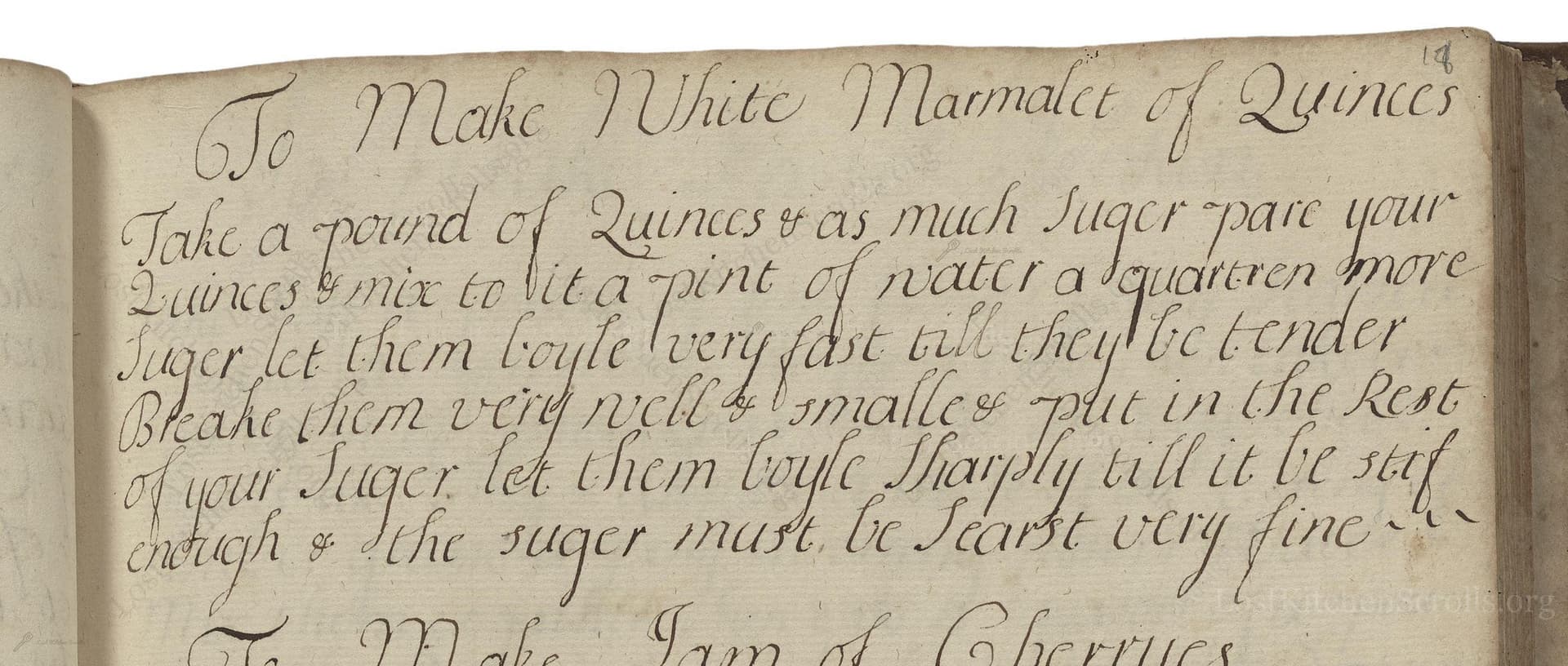To Make White Marmalet Of Quinces
From the treasured pages of Mrs. Rachel Kirk Book 1707
Written by Rachel Kirk

To Make White Marmalet Of Quinces
"Take a pound of Quinces & as much suger pare your Quinces & mix to it a pint of water a quartren more suger let them boyle very fast till they be tender Bleake them very well & smalle & put in the Rest of your suger let them boyle sharply till it be stif enough & the suger must be searst very fine"
Note on the Original Text
The recipe uses direct, imperatives—the typical style for early modern household recipe books, assuming the cook already possessed basic culinary skills. Spelling in 1707 was unstandardized: 'suger' for sugar, 'bleake' for break (or mash), 'searst' for sieved. Quantities are given in pounds and pints, but exact measurements were variable. 'Sharply' means to boil at a brisk, rolling boil. Old recipes would often omit steps assumed as common kitchen knowledge, such as checking for the correct 'set' or consistency.

Title
Mrs. Rachel Kirk Book 1707 (1707)
You can also click the book image above to peruse the original tome
Writer
Rachel Kirk
Era
1707
Publisher
Unknown
Background
A remarkable collection of early 18th-century recipes, Rachel Kirk's work invites readers into the kitchens of the past where classic culinary traditions and timeless flavors come alive. Expect a charming medley of savory feasts and sweet treats reflective of the era's sophisticated palate.
Kindly made available by
Folger Shakespeare Library
This recipe comes from a 1707 manuscript attributed to Rachel Kirk. In early 18th-century England, marmalets (or marmalades) were not the familiar citrus preserves we know today, but rather firm fruit pastes often served as confections or sweetmeats. White marmalet of quinces was prized for its delicate color and flavor, a subtle luxury for a well-to-do household. Sugar had become increasingly accessible, though still expensive, and recipes from this period reflect both the improving availability of sugar and growing interest in fruit preservation.

Quinces were pared and chopped with a sharp knife and pared using a small paring knife. A large brass or copper preserving pan would be used for boiling the quinces. For stirring, a wooden spoon. To achieve a smooth paste, the cooked quinces might be 'bleaked' (broken up) with a wooden paddle, mashed with a pestle or spoon, or even rubbed through a sieve or cloth for extra smoothness. Sugar was often sieved fine using a muslin cloth or wooden sieve.
Prep Time
15 mins
Cook Time
1 hr 10 mins
Servings
8
We've done our best to adapt this historical recipe for modern kitchens, but some details may still need refinement. We warmly welcome feedback from fellow cooks and culinary historians — your insights support the entire community!
Ingredients
- 1 lb quinces (peeled and cored)
- 1 cup granulated sugar (for initial boil)
- 1 cup granulated sugar, sieved very fine (for later addition)
- 2 cups water
Instructions
- Begin by peeling and coring 1 lb of quinces.
- Dice them and place them into a heavy-based saucepan with 2 cups of water and 1 cup of granulated sugar.
- Bring to a boil and cook rapidly over medium-high heat until the quinces are soft and tender, about 30–40 minutes.
- Mash or blend the cooked quinces until very smooth.
- Stir in a further 1 cup of finely sieved sugar.
- Continue to boil the mixture, stirring constantly, until very thick and the mixture holds its shape when spooned onto a cold plate (this may take up to 30 more minutes).
- Pour into a shallow container or onto parchment to set.
Estimated Calories
150 per serving
Cooking Estimates
You will spend about 15 minutes preparing the quinces and ingredients. Cooking the quinces and thickening the mixture will take about 1 hour and 10 minutes. Each serving has about 150 calories, and this recipe makes 8 servings.
As noted above, we have made our best effort to translate and adapt this historical recipe for modern kitchens, taking into account ingredients nowadays, cooking techniques, measurements, and so on. However, historical recipes often contain assumptions that require interpretation.
We'd love for anyone to help improve these adaptations. Community contributions are highly welcome. If you have suggestions, corrections, or cooking tips based on your experience with this recipe, please share them below.
Join the Discussion
Rate This Recipe
Dietary Preference
Main Ingredients
Culinary Technique

Den Bockfisch In Einer Fleisch Suppen Zu Kochen
This recipe hails from a German manuscript cookbook compiled in 1696, a time whe...

Die Grieß Nudlen Zumachen
This recipe comes from a rather mysterious manuscript cookbook, penned anonymous...

Ein Boudain
This recipe comes from an anonymous German-language manuscript cookbook from 169...

Ein Gesaltzen Citroni
This recipe, dating from 1696, comes from an extensive anonymous German cookbook...
Browse our complete collection of time-honored recipes



